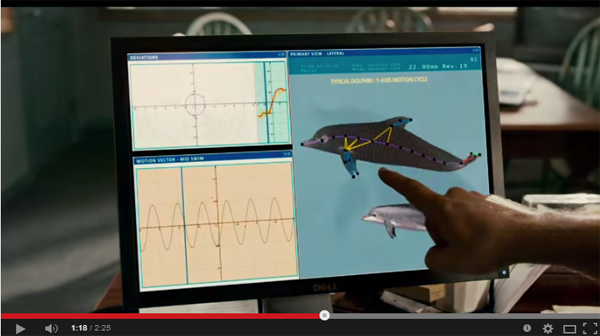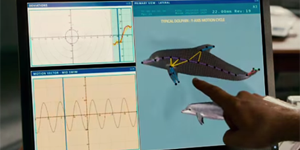A Dolphin Tail and Prosthetics Engineering
In movies like Dolphin Tale, you don't have to look far to find the engineering design process in action. With the steps of the engineering process being acted out as the story unfolds, students see that success often involves a great deal of trial, error, testing, and redesigning. With a dolphin's well-being at stake, succeeding is something audiences cheer about—and succeeding involves science, innovation, technology, and persistence!

We sometimes lag behind when it comes to catching big screen releases, so we first watched Dolphin Tale (2011) (2011) last summer as a rental. The movie, based on a true story, is a great and heartwarming tale about a couple of kids, a rescued dolphin named Winter, and the efforts of a marine biology center in Florida. After Winter's tail has to be amputated, the bottlenose dolphin adapts and learns to swim with a different side-to-side motion. Winter gets around, but doctors at the marine hospital determine her makeshift movements are causing long-term spinal damage.
When 11-year old Sawyer, who was there when Winter was first rescued, faces a family member who has returned from military service with an amputation and meets a doctor that works at the veteran's hospital, he realizes that a prosthetic tail might be just what Winter needs.
He convinces Dr. Cameron McCarthy, played by Morgan Freeman, to help design something specifically for Winter. "Trying to put a tail on a fish. Nobody in his right mind would even try," says Dr. McCarthy. But Winter's plight wins him over, and he goes through a number of trials and iterations of design and engineering in working to develop a custom prosthesis for Winter. The first versions don't succeed, but Dr. McCarthy, Sawyer, and the marine center staff, do not give up. Learning from each failed attempt, Dr. McCarthy continues to refine the tail.
There are many variables involved, including the design and shape, the material from which the tail is made, the weight of the prosthesis, the way in which the tail attaches to Winter, and more. Pinpointing areas for change and improvement, making a new prototype, and trying again are all part of the engineering design process Dr. McCarthy goes through.
For students watching Dolphin Tale, the engineering design process is on display in a way students can immediately see and understand. While Dr. McCarthy waits for materials, he makes a first prototype that Winter rejects. Had he stopped there, what would have happened to Winter? Luckily, he doesn't stop. He continues to work on the design until he develops the first in a series of prosthetic devices to help Winter.
Engineering a Sequel
In Dolphin Tale 2, released this year, there is a new plot line, but Winter's tail is still central to the story. Federal law requires that dolphins are kept with a companion. When Winter's companion dies, the marine center faces the fact that Winter may have to be relocated. The unexpected rescue of Hope, a younger dolphin, looks like it may offer a solution, but only if Hope and Winter become friends. Matching up two dolphins for companionship sounds easier than it proves to be!
When the marine center staff first introduce Winter and Hope, the meeting goes badly. Watching replays of the meeting, doctors and scientists theorize that Hope detected Winter's missing tail and that this made Winter seem too "different" to the younger dolphin. Still hoping for the two dolphins to become companions, Dr. McCarthy designs a new and even more realistic version of Winter's tail.
Together, the two movies offer a family-friendly and accessible look into the engineering design process and biomedical engineering. There is a great deal of science and engineering for families (or classes) to talk about in these movies. Students can also get inspired by the science they see and turn their interest into a hands-on science experiment.
Student Science and Prosthetics Design
Students can experiment with the brainstorming, design, prototyping, and testing that goes into prosthetics (and other biomedical or robotics engineering) design with projects like these:
- Grasping with Straws: Make a Robot Hand Using Drinking Straws
- Build a Helping Hand *
- Squishy Robots: Build an Air-Powered Soft Robotic Gripper
- Deep Knee Bends: Measuring Knee Stress with a Mechanical Model
3D Printing and Prosthetics
3D printing is revolutionizing the way we think about product manufacturing. While we often hear about 3D printing for small-scale items like phone cases, accessories, or parts to replace something that has broken, 3D printing is being used to create all kinds of products, including custom human prosthetics. In October, the Washington Post ran a piece on a cool "Iron Man"-styled prosthetic hand for children. In the video demonstration, the creator talks about the goals that helped guide the design of the hand.
Students can begin to explore 3D printing and design with free Autodesk design software. Projects to help kids get started are available on the Digital STEAM Workshop site. Students working on science projects can also use Autodesk software to take their projects to the next level. A great first step with 3D design is to use Autodesk software to expand Science Buddies' beginner-level Artbot project into a customized 3D robotics engineering exploration. The Design and 3D-Print Your Own Robot! * project helps students think through what may be involved and how to use 3D design as a fulcrum for an independent robotics engineering exploration.
For more information about using Autodesk software, and for other suggestions about projects that can be integrated with Autodesk, see Level Up Your Science Fair Project: Design in 3D with Free Autodesk Software.
For related stories of animal-related prosthetics engineering, 3D design, and innovation, see:
- Derby the dog runs miles with 3D printed prosthetics
- Disabled tortoise gets a Lego 'wheelchair'
- 'TurboRoo' puppy gets wheels thanks to 3D printing
Categories:
You Might Also Enjoy These Related Posts:
- Plastics and Earth Day - Science Projects
- Arduino Science Projects and Physical Computing
- 10+ Robotics Projects with the BlueBot Kit
- 5 STEM Activities with Marshmallow Peeps
- March Madness Basketball Science Projects: Sports Science Experiments
- Women in STEM! More than 60 Scientists and Engineers for Women's History Month
- Explore Artificial Intelligence and Machine Learning with Student AI Projects
- 10 Reasons to Do the Rubber Band Car Engineering Challenge










